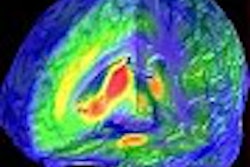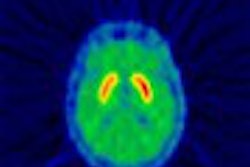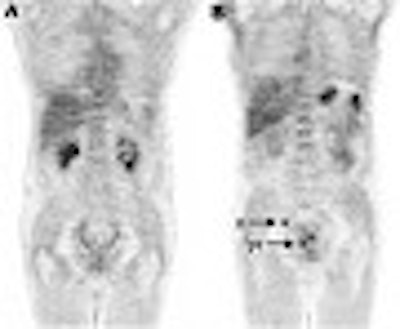
Even after radical prostatectomy, close to a third of men with detectable prostate-specific antigen (PSA) levels still experience local recurrence. In addition, 70% are likely to have distant metastases alone or in addition to local recurrence. For these patients, the type of treatment -- radiotherapy, systemic chemotherapy -- is based on whether the disease is localized in the prostate fossa. Imaging with 11C-acetate PET (AC-PET) has shown promise for the detection of recurrent disease at PSA relapse, according to a group from the Mallinckrodt Institute of Radiology in St. Louis.
"Our study was designed to evaluate patients with AC-PET as soon as PSA recurrence was recognized, at which time the PSA is relatively low. In such patients, there is a greater possibility that recurrent disease will be detected by imaging before it has spread to regional or distant lymph nodes or other organs, and there is thus a greater possibility for cure by salvage therapy," wrote lead author Dr. Nobuyuki Oyama in the latest issue of the Journal of Nuclear Medicine. Oyama’s co-authors are from Mallinckrodt as well as the Washington University School of Medicine, also in St. Louis.
For this study, 46 patients with adenocarcinoma of the prostate were divided into two groups: Group A had recurrent disease as manifested by a detectable serum PSA after radical prostatectomy. Group B consisted of patients for whom radiation therapy had failed as a primary treatment. The mean PSA values were 4.9 ng/mL for group A and 5.8 ng/mL for group B.
All patients underwent AC-PET and 18F-FDG-PET on the same day. They were injected with 1,110 MBq (30 mCi) of 11C-acetate and underwent 15 minutes of dynamic emission imaging of the pelvis. At the end of that imaging sequence, 555 MBq (15 mCi) of 18F-FDG was administered and a series of transmission and emission scans were obtained. The typical reconstructed resolution was 8 mm in full width at half maximum, the authors stated.
Two experienced readers evaluated the FDG-PET images first, followed by the AC-PET data. When available, the PET findings were correlated with the results of biopsy or directly with bone scintigraphy, x-ray, or CT.
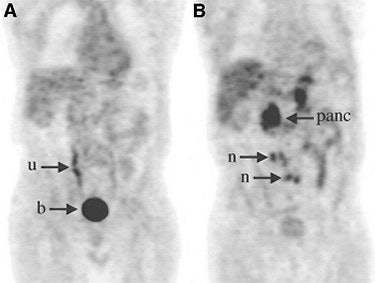 |
| Above, a 77-year-old man with PSA relapse and a serum PSA value of 10.5 ng/mL. The patient underwent radical prostatectomy and salvage external-beam radiation. The coronal FDG-PET image (A) showed only urinary activity in the right ureter (u) and bladder (b). The AC-PET (B) image indicates high uptake in the multiple paraortic lymph nodes (n), and normal uptake in the pancreas (panc). Image and caption courtesy of Dr. Nobuyuki Oyama and the Journal of Nuclear Medicine. |
According to the results, 59% (27 of 46) had positive findings on AC-PET, which were considered indicative of a high or intermediate probability for recurrent tumor. In contrast, 17% of the FDG-PET results had positive findings.
"In group A, local recurrence was detected by AC-PET in two patients (7%), with one confirmed biopsy. Ten patients (33%) had lymph node metastases. Two patients (7%) had bone metastases. In group B, 10 patients (62%) showed positive AC-PET findings in the prostate bed, with two confirmed by biopsy. Six group B patients (38%) had lymph node metastases. Two group B patients (13%) had bone metastases," the authors wrote (JNM, April 2003, Vol. 44:4, pp. 549-555).
Thirteen out of 22 patients who had a serum PSA level greater than 3 ng/mL had a high probability of recurrence on AC-PET; one out of 24 patients with a serum PSA less than or equal to 3 ng/mL had a high-probability study.
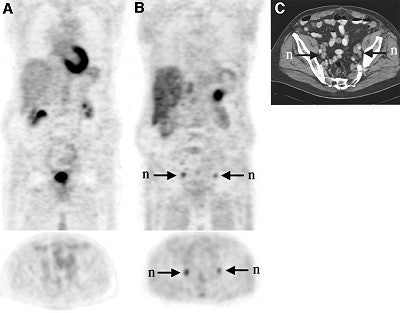 |
| The 73-year-old patient shown above had an increasing serum PSA value of 9.1 ng/mL, two years after undergoing external beam radiation therapy. Coronal and transaxial FDG-PET images (A) show no uptake in prostate and pelvic lymph nodes. The coronal and transaxial AC-PET images (B) show bilateral high uptake in the iliac lymph nodes. The CT scan shows corresponding 1.5-cm iliac nodes (n). Image and caption courtesy of Dr. Nobuyuki Oyama and the Journal of Nuclear Medicine. |
The superiority of AC-PET over FDG-PET for imaging recurrence may be related to tracer accumulation in the tumor cells, the authors stated. "Given the highly active basal lipid metabolism in the cell membrane associated with tumor growth, 11C-acetate may be an important probe of this anabolic lipid pathway," they stated. In comparison, the slow rate of growth for prostate tumors means a low glucose metabolic rate, which affects FDG-PET performance.
The group acknowledged that AC-PET does have some limitations, most notably a low spatial resolution of 8 mm. Also, because serum PSA level correlates with tumor volume in prostate cancer, AC-PET may not be of value in patients with low serum PSA levels.
Another team, this one from Hanover, Germany, will advance the cause of AC-PET for prostate recurrence at the upcoming American Urological Association meeting in Chicago. In a poster presentation tomorrow, Dr. Stefan Machtens and colleagues will outline their experience with this modality. Their study consisted of 25 patients who underwent AC-PET and FDG-PET imaging during follow-up of primary prostate cancer treatment (Abstract No.105687).
They found that primary tumors were visualized in 83% of the cases with AC-PET, and in 75% of the patients with FDG-PET. Based on the results of both PET scans, one patient was diagnosed with a lung cancer as well. They also found that the average 18F-FDG uptake was higher in distant metastases, whereas 11C-acetate uptake was higher in local recurrence and in local lymph node metastases. As with the Mallinckrodt study, the German group reported a closer relationship between serum PSA level and AC-PET imaging results.
By Shalmali PalAuntMinnie.com staff writer
April 28, 2003
Related Reading
IR spectroscopy can assess prostate cancer risk and stage, April 18, 2003
New reports address prostate cancer staging, therapy, April 24, 2003
Predictors of PSA relapse after radiotherapy for prostate cancer identified, May 17, 2002
Copyright © 2003 AuntMinnie.com





